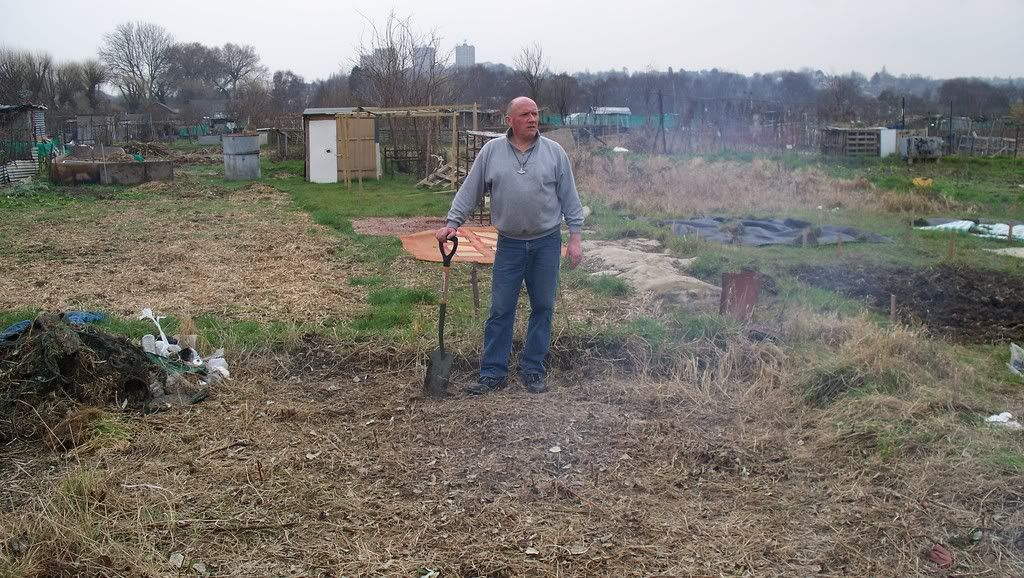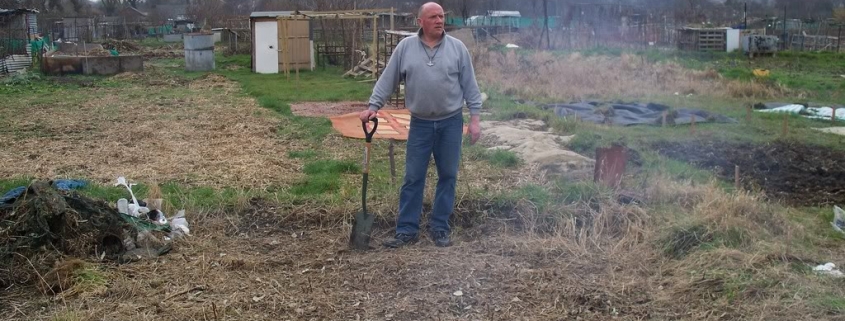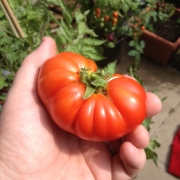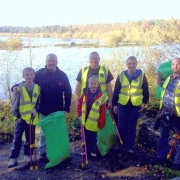The Idunn Project – South East
by Jim C AOR
About a Year ago, inspired by the Idun Project I decided to apply to my local government authority for an allotment. Earlier this year I took possession of a plot of 8 rods. A rod (The word rod derives from Old English rodd and is akin to Old Norse rudda) is equivalent to 16 feet 5inches in length. I was looking forward to preparing my plot and without illusions I set off. I wasn’t expecting freshly dug soil ready for Planting, but neither was I expecting a piece of overgrown land with piles of discarded wood and the odd carpet thrown in; Ground Force this wasn’t. A lot of work would have to be done before I could begin to dream of freshly dug potatoes in the autumn sunshine, and later as you will see, some of the wood and the carpets would come in useful.
 The first thing I did was to identify some sections that showed signs of recent propagation. They were overgrown with weeds and couch grass; digging the roots of couch grass is hard work, they are dense and bind even the lightest soil. Burying or turning couch grass will not kill it. The roots will spread and shoots will reappear, it also grows extremely quickly. If I was going to do things organically there was no alternative to hard work. As I continued clearing the ground it seemed sensible to separate the area into smaller more manageable sections, and I decided it would be a much less daunting task if I dug one bed at a time, rather than try to clear the entire plot before planting. Using some wood I found discarded around the site I created some slightly raised beds. It’s best to use wood that is not chemically treated; otherwise contaminants can leak into the soil. Once the beds were dug I also cleared an area around them to stop the couch grass re-establishing itself. Continued weeding will be needed over the next few months to completely remove any grass that reappears from roots left in the ground.
The first thing I did was to identify some sections that showed signs of recent propagation. They were overgrown with weeds and couch grass; digging the roots of couch grass is hard work, they are dense and bind even the lightest soil. Burying or turning couch grass will not kill it. The roots will spread and shoots will reappear, it also grows extremely quickly. If I was going to do things organically there was no alternative to hard work. As I continued clearing the ground it seemed sensible to separate the area into smaller more manageable sections, and I decided it would be a much less daunting task if I dug one bed at a time, rather than try to clear the entire plot before planting. Using some wood I found discarded around the site I created some slightly raised beds. It’s best to use wood that is not chemically treated; otherwise contaminants can leak into the soil. Once the beds were dug I also cleared an area around them to stop the couch grass re-establishing itself. Continued weeding will be needed over the next few months to completely remove any grass that reappears from roots left in the ground.

In one corner of the allotment taking up about an eighth of the total area, were some brambles; they were badly overgrown and were encroaching on other people’s allotments. I decided they had to go, and it took me several hours of hard graft to cut them down. A timely visit to the allotment by Sam C gave the work added impetus and in no time we had a raging fire going. We deposited the brambles and any wood not fit for purpose on the flames. I then attempted to dig the roots up; a bad mistake when you are already knackered. To my utter dismay I discovered the roots of a bramble travel several feet underground and not necessarily in a straight line. It didn’t take long for me to decide that a different tactic was needed and to cover them with an old carpet would suffice for now.
The soil is quite heavy with clay and sticks to fork and shovel. Clay soil has its pros and cons; it is capable of holding more of the nutrients your plants need than any other type of soil. The trouble with clay soil is that it doesn’t just hold onto nutrients. It holds onto water too meaning that you are likely to have poor drainage. The small particles in clay soil bind together more easily, squeezing out the air and making it more difficult for water to drain away. This lack of air in the soil is also damaging to plants, worms and tiny organisms in the soil because it literally suffocates them. I could treat it with Gypsum to help break the clay up, but there will be no instant gratification, as it will take between 1 and 3 years to show signs of improvement. The other method would be to add organic material; this will not only improve fertility but also attract earthworms, which will burrow through the soil opening it up.
I plan to grow several crops of potatoes as well as onions, garlic, cauliflowers and corn. It’s easy to get carried away and try to grow too many things at first, so I’m keeping it simple, so far I’ve planted the garlic and onions sets and a crop of early seed potatoes. It was satisfying to see the beds laid out and the seed in the ground. On that day I took time out to thank the Gods and did a short protection ritual.

I’ve already learnt so much, i.e. comfrey leaves are an excellent fertilizer for potatoes, and potatoes are good for breaking up the soil. Also the best way to start corn off is to chit the seeds; this entails wetting two pieces of paper and placing the seed between them, then you place it in a container and keep it in the dark until the seed germinates. Once that’s done you can plant it in a seed tray until you’ve got about five leaves, and then it’s ready for planting out around late April or early May.
After a couple of months and a 3 week break to recover from a knee op I realize that much of what I am doing is preparation for next year. I returned to the allotment after the break to find the dastardly couch grass had started to take hold once more. I had to abandon my plans to plant a main crop of seed potatoes and instead gave my established beds a thorough weeding. It was pleasing to see the green shoots of my onions, garlic and early potatoes breaking through the soil, so I still hope to reap some rewards from the hard work I’ve put in so far.
At times it has been physically demanding, but it has also been rewarding. I’m happy with what I’ve achieved so far and look forward to sharing the highs and lows of the year to come, having already experienced varying degrees of emotion from despair to joy.
Hail Thor
Hail the OR
SWWS
FFF
Jim C







Great article Jim, I enjoyed reading it and learnt a couple of things too. Well done comrade, looking forward to the next one so keep at it!
Sam FFF
Great stuff Jim, let’s hope more shed heads sign up and get digging.